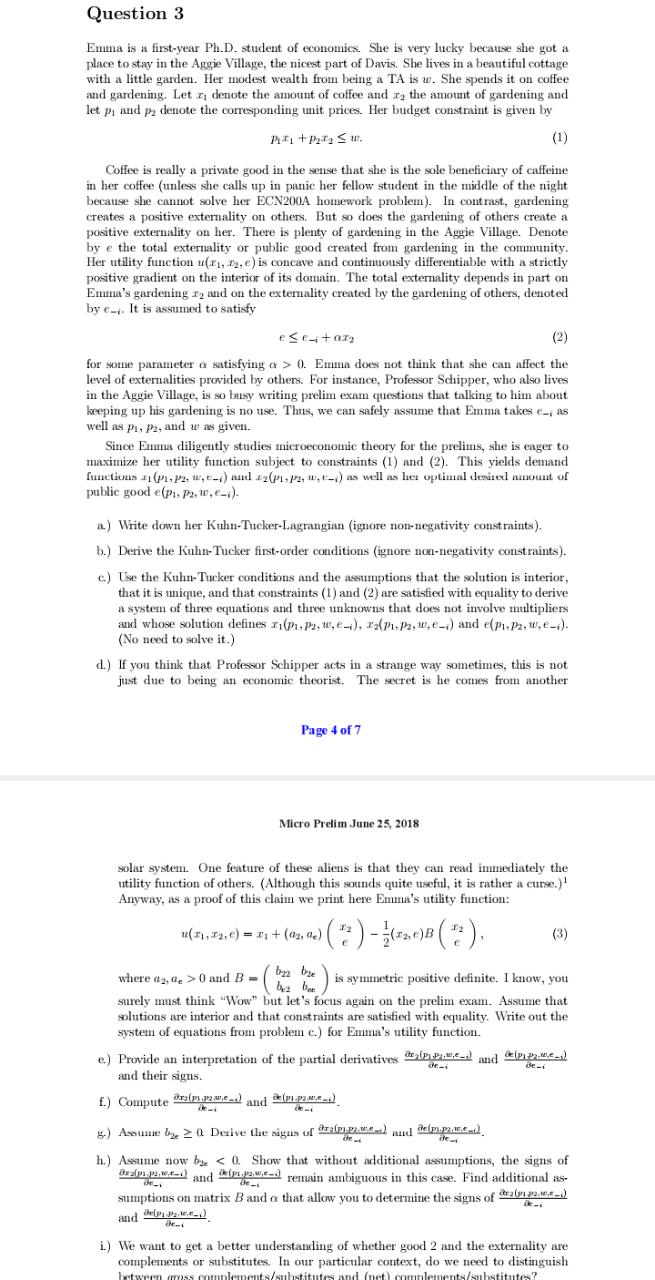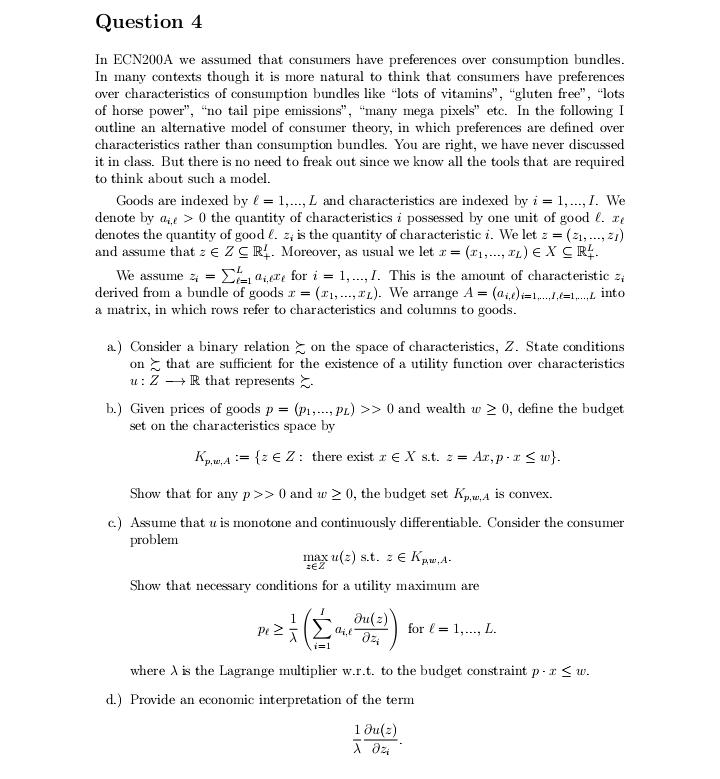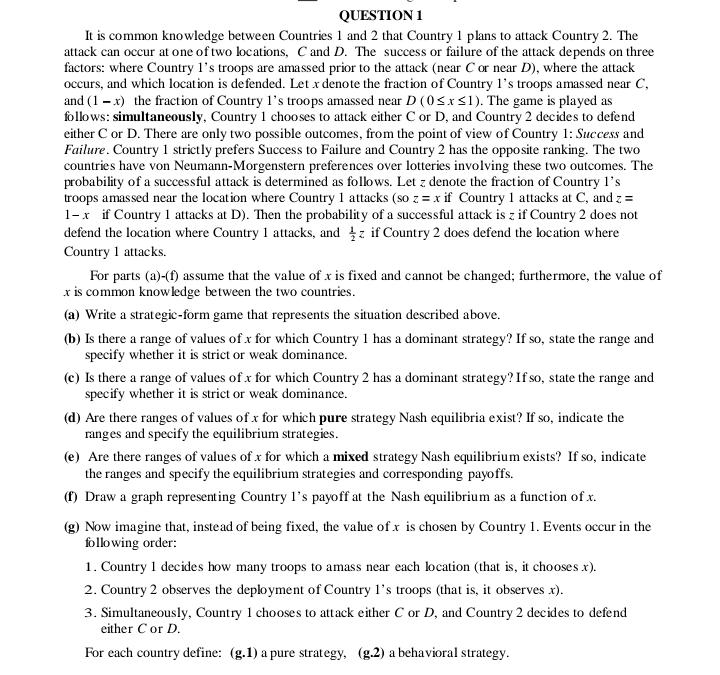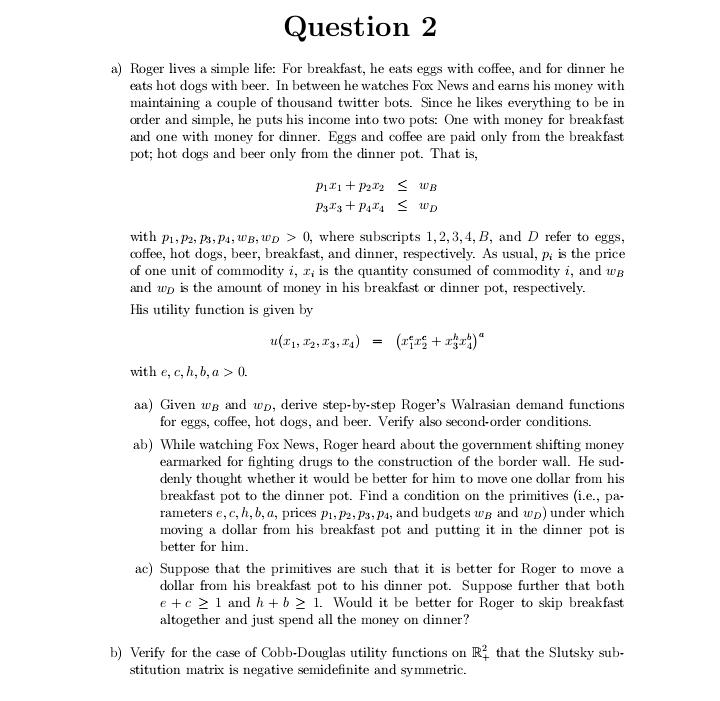



Macroeconomics problems solve...
Question 3 Emma is a first-year Ph.D. student of economics. She is very lucky because she got a place to stay in the Aggie Village, the nicest part of Davis. She lives in a beautiful cottage with a little garden. Her modest wealth from being a TA is w. She spends it on coffee and gardening. Let z, denote the amount of coffee and z, the amount of gardening and let p, and p2 denote the corresponding unit prices. Her budget constraint is given by (1) Coffee is really a private good in the sense that she is the sole beneficiary of caffeine in her coffee (unless she calls up in panic her fellow student in the middle of the night because she cannot solve her ECN200A homework problem). In contrast, gardening creates a positive externality on others. But so does the gardening of others create a positive externality on her. There is plenty of gardening in the Aggie Village. Denote by e the total externality or public good created from gardening in the community. Her utility function u(11, 12, e) is concave and continuously differentiable with a strictly positive gradient on the interior of its domain. The total externality depends in part on Emma's gardening ry and on the externality created by the gardening of others, denoted by e-1. It is assumed to satisfy ese-it ary (2) for some parameter a satisfying a > 0. Emma does not think that she can affect the level of externalities provided by others. For instance, Professor Schipper, who also lives in the Aggie Village, is so busy writing prelim exam questions that talking to him about keeping up his gardening is no use. Thus, we can safely assume that Emma takes e-, as well as pi, pz, and w as given. Since Emma diligently studies microeconomic theory for the prelims, she is eager to maximize her utility function subject to constraints (1) and (2). This yields demand functions n (pi, pz, w, e-,) and zz(pi,pz, w, E-1) as well as her optimal desized amount of public good e(p1, pz. w0, e-;). a) Write down her Kuhn-Tucker-Lagrangian (ignore non-negativity constraints). b.) Derive the Kuhn-Tucker first-order conditions (ignore non-negativity constraints). c.) Use the Kuhn-Tucker conditions and the assumptions that the solution is interior, that it is unique, and that constraints (1) and (2) are satisfied with equality to derive a system of three equations and three unknowns that does not involve multipliers and whose solution defines r(p, pz, w, e-;), I2(Pi. Pz, w, e-.) and e(p1. P2, w. e-;). (No need to solve it.) d.) If you think that Professor Schipper acts in a strange way sometimes, this is not just due to being an economic theorist. The secret is he comes from another Page 4 of 7 Micro Prelim June 25, 2018 solar system. One feature of these aliens is that they can read immediately the utility function of others. (Although this sounds quite useful, it is rather a curse.)' Anyway, as a proof of this claim we print here Emma's utility function: (3) where a2, de > 0 and B = bez bee is symmetric positive definite. I know, you surely must think "Wow" but let's focus again on the prelim exam. Assume that solutions are interior and that constraints are satisfied with equality. Write out the system of equations from problem c.) for Emma's utility function. e) Provide an interpretation of the partial derivatives PLPte- and app.me_) de-. de-i and their signs. f.) Compute andpumame- and delmi.pamve-) ") Assume bye 2 0 Derive the signs of grammame-d and delmi.mine. de_ de_ h.) Assume now be 0 the quantity of characteristics i possessed by one unit of good f. If denotes the quantity of good /. z, is the quantity of characteristic i. We let z = (21, ..., 27) and assume that = E Z C R4. Moreover, as usual we let z = (31,..., DL) E X C RF. We assume & = >_ query for i = 1,..., I. This is the amount of characteristic z; derived from a bundle of goods r = (21, -.., IL). We arrange A = (at)izi...f.=..,f into a matrix, in which rows refer to characteristics and columns to goods. a.) Consider a binary relation _ on the space of characteristics, Z. State conditions on - that are sufficient for the existence of a utility function over characteristics u : Z - R that represents - b.) Given prices of goods p = (p1,..., PL) > > 0 and wealth w 2 0, define the budget set on the characteristics space by Kow,A := {ze Z : there exist re X s.t. = = Ar, p . I S w}. Show that for any p > > 0 and w 2 0, the budget set Ap,w,A is convex. c.) Assume that u is monotone and continuously differentiable. Consider the consumer problem max u (z) s.t. = E Kow,A- Show that necessary conditions for a utility maximum are au(=) Pe 2 X Out dzi for { = 1,..., L. where A is the Lagrange multiplier w.r.t. to the budget constraint p - r S w. d.) Provide an economic interpretation of the term 1 du(=) A OzQUESTION 1 It is common knowledge between Countries 1 and 2 that Country 1 plans to attack Country 2. The attack can occur at one of two locations, C and D. The success or failure of the attack depends on three factors: where Country I's troops are amassed prior to the attack (near C or near D), where the attack occurs, and which location is defended. Let x denote the fraction of Country 1's troops amassed near C. and (1 - x) the fraction of Country I's troops amassed near D (0 Sx 1). The game is played as follows: simultaneously, Country 1 chooses to attack either C or D, and Country 2 decides to defend either C or D. There are only two possible outcomes, from the point of view of Country 1: Success and Failure. Country 1 strictly prefers Success to Failure and Country 2 has the opposite ranking. The two countries have von Neumann-Morgenstern preferences over lotteries involving these two outcomes. The probability of a successful attack is determined as follows. Let z denote the fraction of Country I's troops amassed near the location where Country I attacks (so z = x if Country 1 attacks at C, and z = 1- x if Country 1 attacks at D). Then the probability of a successful attack is z if Country 2 does not defend the location where Country 1 attacks, and + z if Country 2 does defend the location where Country 1 attacks. For parts (a)-(f) assume that the value of a is fixed and cannot be changed; furthermore, the value of x is common knowledge between the two countries. (a) Write a strategic-form game that represents the situation described above. (b) Is there a range of values of x for which Country I has a dominant strategy? If so, state the range and specify whether it is strict or weak dominance. (c) Is there a range of values of x for which Country 2 has a dominant strategy? If so, state the range and specify whether it is strict or weak dominance. (d) Are there ranges of values of x for which pure strategy Nash equilibria exist? If so, indicate the ranges and specify the equilibrium strategies. (e) Are there ranges of values of x for which a mixed strategy Nash equilibrium exists? If so, indicate the ranges and specify the equilibrium strategies and corresponding payoffs. (f) Draw a graph representing Country I's payoff at the Nash equilibrium as a function of x. (g) Now imagine that, instead of being fixed, the value of x is chosen by Country 1. Events occur in the following order: 1. Country I decides how many troops to amass near each location (that is, it chooses x). 2. Country 2 observes the deployment of Country I's troops (that is, it observes x). 3. Simultaneously, Country 1 chooses to attack either C or D, and Country 2 decides to defend either C or D. For each country define: (g.1) a pure strategy, (g.2) a behavioral strategy.Question 2 a) Roger lives a simple life: For breakfast, he eats eggs with coffee, and for dinner he eats hot dogs with beer. In between he watches Fox News and earns his money with maintaining a couple of thousand twitter bots. Since he likes everything to be in order and simple, he puts his income into two pots: One with money for breakfast and one with money for dinner. Eggs and coffee are paid only from the breakfast pot; hot dogs and beer only from the dinner pot. That is, PyTa + PATA = WD with pi, P2, P, PA, WB, WD > 0, where subscripts 1, 2, 3,4, B, and D refer to eggs, coffee, hot dogs, beer, breakfast, and dinner, respectively. As usual, p; is the price of one unit of commodity i, r, is the quantity consumed of commodity i, and we and wp is the amount of money in his breakfast or dinner pot, respectively. His utility function is given by with e, c, h, b, a > 0. aa) Given wg and wp, derive step-by-step Roger's Walrasian demand functions for eggs, coffee, hot dogs, and beer. Verify also second-order conditions. ab) While watching Fox News, Roger heard about the government shifting money earmarked for fighting drugs to the construction of the border wall. He sud- denly thought whether it would be better for him to move one dollar from his breakfast pot to the dinner pot. Find a condition on the primitives (i.e., pa- rameters e, c, h, b, a, prices pi, p2, pa, pa, and budgets ws and wp) under which moving a dollar from his breakfast pot and putting it in the dinner pot is better for him. ac) Suppose that the primitives are such that it is better for Roger to move a dollar from his breakfast pot to his dinner pot. Suppose further that both ete 2 1 and h + b 2 1. Would it be better for Roger to skip breakfast altogether and just spend all the money on dinner? b) Verify for the case of Cobb-Douglas utility functions on Rf that the Slutsky sub- stitution matrix is negative semidefinite and symmetric














